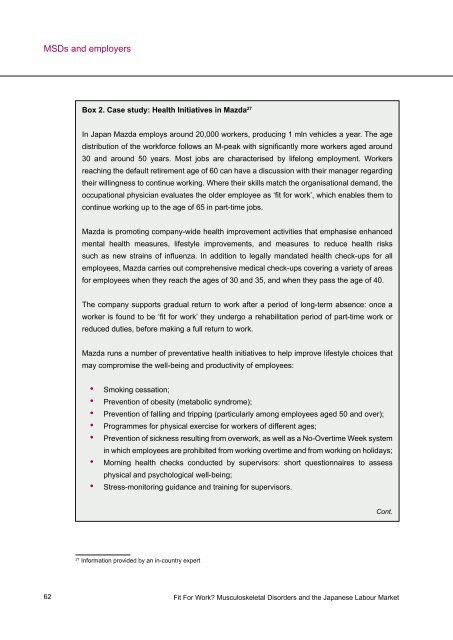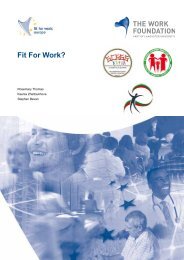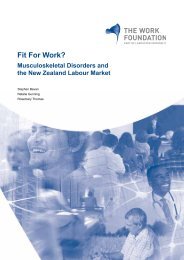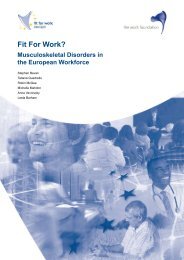English version - Fit for Work Europe
English version - Fit for Work Europe
English version - Fit for Work Europe
You also want an ePaper? Increase the reach of your titles
YUMPU automatically turns print PDFs into web optimized ePapers that Google loves.
MSDs and employers<br />
62<br />
Box 2. Case study: Health Initiatives in Mazda 27<br />
In Japan Mazda employs around 20,000 workers, producing 1 mln vehicles a year. The age<br />
distribution of the work<strong>for</strong>ce follows an M-peak with significantly more workers aged around<br />
30 and around 50 years. Most jobs are characterised by lifelong employment. <strong>Work</strong>ers<br />
reaching the default retirement age of 60 can have a discussion with their manager regarding<br />
their willingness to continue working. Where their skills match the organisational demand, the<br />
occupational physician evaluates the older employee as ‘fit <strong>for</strong> work’, which enables them to<br />
continue working up to the age of 65 in part-time jobs.<br />
Mazda is promoting company-wide health improvement activities that emphasise enhanced<br />
mental health measures, lifestyle improvements, and measures to reduce health risks<br />
such as new strains of influenza. In addition to legally mandated health check-ups <strong>for</strong> all<br />
employees, Mazda carries out comprehensive medical check-ups covering a variety of areas<br />
<strong>for</strong> employees when they reach the ages of 30 and 35, and when they pass the age of 40.<br />
The company supports gradual return to work after a period of long-term absence: once a<br />
worker is found to be ‘fit <strong>for</strong> work’ they undergo a rehabilitation period of part-time work or<br />
reduced duties, be<strong>for</strong>e making a full return to work.<br />
Mazda runs a number of preventative health initiatives to help improve lifestyle choices that<br />
may compromise the well-being and productivity of employees:<br />
• Smoking cessation;<br />
• Prevention of obesity (metabolic syndrome);<br />
• Prevention of falling and tripping (particularly among employees aged 50 and over);<br />
• Programmes <strong>for</strong> physical exercise <strong>for</strong> workers of different ages;<br />
• Prevention of sickness resulting from overwork, as well as a No-Overtime Week system<br />
in which employees are prohibited from working overtime and from working on holidays;<br />
• Morning health checks conducted by supervisors: short questionnaires to assess<br />
physical and psychological well-being;<br />
• Stress-monitoring guidance and training <strong>for</strong> supervisors.<br />
27 In<strong>for</strong>mation provided by an in-country expert<br />
Cont.<br />
<strong>Fit</strong> For <strong>Work</strong>? Musculoskeletal Disorders and the Japanese Labour Market







